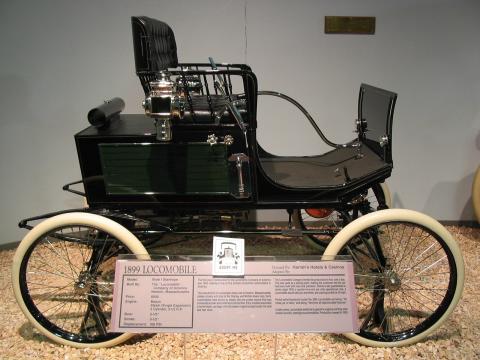
1899 LOCOMOBILE
| MODEL: | Style 1 Stanhope |
| BUILT BY: | he "Locomobile" Company of America Newton, Massachusetts |
| PRICE: | $600.00 |
| ENGINE: | Mason Steam (Single Expansion) 2 Cylinder, 3-1/2 H.P. |
| BORE: | 2-1/2" |
| STROKE: | 3-1/2" |
| DISPLACEMENT: | 160 PSI |
In the summer of 2001, Allyn Kilsheimer was about to fulfill his dream of owning a car from the earliest days of
automobiles. He answered an ad for an 1899 Locomobile placed by a man in Bear Lake, Calif., who was looking
for a good home for his little steam runabout.
The buyer and seller are both engineers, which was helpful during
the getting acquainted phase of the initial interview.
Eventually, the seller decided that Kilsheimer passed muster
and the deal for the then 102-year-old car was made over the telephone.
Kilsheimer sent the California man the
money and in the spring of 2002, the Locomobile was trucked cross country to Kilsheimer's Washington, D.C. home.
He was ecstatic when his little steam car arrived.
The 1899 Locomobile is 4 feet, 5 inches wide and 5 feet,
4 inches tall (to the top of the seat back). It is 7 feet, 3 inches long bumper-to-bumper - though it has no "bumpers."
The entire rig is supported on a 57-inch wheelbase by white rubber 28x3-inch, four-ply tires mounted on 40-spoke
nickel-plated bicycle wheels. With a full load of five gallons of water and three gallons of gasoline the total weight is
still less than 700 pounds.
The little steamer has a black wooden Stanhope body with a spindle seat. On either end
of the dashboard are vertical slots for the reins controlling a horse to pass through, evidence that the body was initially
made for use as a horse-drawn carriage.
Once Kilsheimer had possession of the car, he corresponded with the
previous owner in an attempt to learn how to operate the five wooden-handled valves behind the leather flap located
behind the driver's ankles. The six-metal-handled valves on the outside of the car also posed perplexing questions.
The previous owner sent him a cryptic message: "Don't try to start it!" Kilsheimer abided by the warning not to light
the boiler, but he did hook the Locomobile to a compressed air hose and actually drove his car on the limited tether
in his driveway propelled by air under pressure instead of steam under pressure. "I wanted to make sure it ran," he
says. Compressed air works just as well as steam to verify the workings of the engine.
The horsehair-packed tufted
leather seat cushion sits directly over the boiler, Ottawa burner, Maxwell pilot and Mason engine. What would
have been cargo space behind the seat in a horse-drawn carriage is a water tank shrouded by a leather cover with
a flap for access to fill the tank.
|